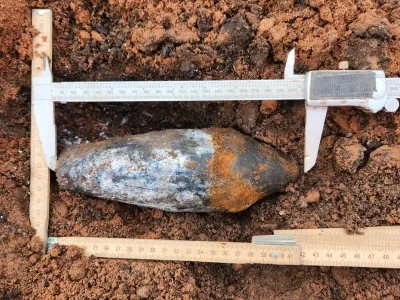Home » Resources » Case Studies »
Case Study Overview
Location
Avonmouth, Bristol
Industry
Construction
Project Duration
June – September 2018
Services
Detailed UXO Risk Assessment
Non-intrusive UXO Survey
UXO Support
Target Investigation
UXO Risk
‘Medium-Risk’ of German UXO
Challenge
In June 2018, 1st Line Defence were commissioned to assess the risk of UXO contamination being present on a new development site in Avonmouth, Bristol.
The site comprised of an open area of marshland adjacent to some large industrial infrastructure. The client’s brief was to assess the site to determine whether any UXO risk was present before ground works commenced, and if there was a risk – to manage the land remediation procedure in-line with CIRIA C681 guidance.
Process
Stage 1 – Detailed UXO Risk Assessment
A Detailed UXO Risk Assessment of the site area was undertaken and archival research found that two 250kg (HE) unexploded bombs (UXBs) were recorded in the south-western area of the site during the war – and that the area was also heavily affected by incendiary bombing during WWII.
There was a viable risk that additional UXB’s or unexploded incendiary devices may still be present, and the site was assessed to be at a ‘Medium-Risk’ of UXO contamination being present.
Stage 2 – Risk Mitigation Strategy
Due to the ground conditions and shallow nature of the proposed works, it was recommended that a Non-intrusive UXO Survey would be the best possible solution to minimise the risk to as low as reasonably practicable (ALARP).
This methodology would cover all areas of the site that were being developed, and if any UXO-related items were discovered – they could be checked, identified and safely removed.
Stage 3 – Non-intrusive UXO Survey
The UXO Survey team undertook a walkover Non-intrusive UXO Survey of the entire site area.
Following data processing / interpretation, a number of discreet anomalies were detected in the otherwise clean ground – including higher levels of contamination in the south-west corner of the site. A list of targets were modelled and selected for investigation by the Target Investigation team.
Stage 4 – UXO Support
Target Investigation of these targets involved a two-man team (equipped with GPS positioning equipment and hand-held UXO detectors) to locate, excavate and inspect the anomalies in a controlled and safe manner.
The team recovered of a number of partially expended 1kg German incendiary bombs, and the base of an anti-aircraft projectile. Pieces of shrapnel were also found in the areas of higher ferrous contamination, this might have been the remnants of the two 250kg UXB’s – which were most likely destroyed in-situ.
Outcome
Following approximately four-months of assessments, surveys and ground investigations, the client was issued with a report confirming that the risk had been reduced to ALARP status, and the client completed the project on-schedule without finding any other UXO-related or suspicious items.
Click on the following link to download a PDF copy of the Case Study for Avonmouth, Bristol.
Latest Case Studies
Do you have a project in Bristol? Need advice but not sure where to start?
If you need advice about UXO risk mitigation in Bristol, contact us today and we will guide you through the process.
Contact Us
* indicates required fields























